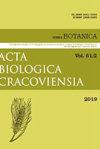Cd2+在体外条件下对柳树生物量的微生物刺激分析——植物修复的意义
IF 0.5
4区 生物学
Q4 PLANT SCIENCES
引用次数: 8
摘要
植物修复的效率可能受到植物相关微生物的高度影响,对其潜在机制的了解仍然是一个巨大的挑战。本研究的主要目的是评估柳树(Salix viminalis)生物量中Cd 2+积累的效率参数,并确定寄主植物在受控的体外条件下接种特定菌株(Massilia sp.和Pseudomonas sp.)或腐生真菌(Clitocybe sp.)时的生化反应。接种菌株影响植物修复过程的效率,表现为累积Cd (Q)、生物积累因子(BCF)和易位指数(Ti);然而,这种效果是菌株和植物器官特异性的。过氧化氢(h2o2)是植物对生物和/或非生物环境胁迫反应的一个指标,也是参与植物与微生物相互作用的一个分子。在未接种的植物中,过氧化氢(h2o2)水平在Cd 2+的影响下下降(植物生长受到Cd 2+的抑制),而在接种了Cd 2+(微生物刺激的生物量)的植物中,过氧化氢水平上升。腐生真菌Clitocybe sp.在所有被研究的植物器官和实验变异体中普遍刺激生物量和提高h2o2合成水平。我们认为,测定寄主植物在体外条件下的物理修复效率和生化反应(h2o2)有助于在进一步的田间试验中预测植物-微生物系统的最终效果。本文章由计算机程序翻译,如有差异,请以英文原文为准。
Analysis of microbiologically stimulated biomass of Salix viminalis L. in the presence of Cd2+ under in vitro conditions – implications for phytoremediation
The efficiency of phytoremediation might be highly affected by plant-associated microorganisms, and under- standing of the underlying mechanisms is still a great challenge. The primary aim of this study was to evaluate the efficiency parameters for Cd 2+ accumulation in the biomass of willow ( Salix viminalis ) as well as to define the biochemical response of the host plant when it is inoculated with selected bacterial strains ( Massilia sp. and Pseudomonas sp.) or saprophytic fungus ( Clitocybe sp.) under controlled in vitro conditions. Inoculation of plants with bacterial strains affected the efficiency of phytoremediation process and was expressed as the quantity of accumulated Cd (Q), the bioaccumulation factor (BCF) and the translocation index (Ti); however, the effect was strain and plant organ specific. The level of hydrogen peroxide (H 2 O 2 ), which is both an indicator of plant response to biological and/or abiotic environmental stress and a molecule involved in plant-microbial interac- tions, decreased under the influence of Cd 2+ in uninoculated plants (plant growth was inhibited by Cd 2+ ) and increased in the inoculated variants of plants growing in the presence of Cd 2+ (microbiologically stimulated bio- mass). The saprophytic fungus Clitocybe sp. generally stimulated biomass and increased the level of H 2 O 2 synthesis in all the investigated plant organs and variants of the experiment. We suggest that determination of phy- toremediation efficiency, and biochemical response (H 2 O 2 ) of the host plant under in vitro conditions can help in predicting the final effect of plant-microbial systems in further field trials.
求助全文
通过发布文献求助,成功后即可免费获取论文全文。
去求助
来源期刊
CiteScore
3.00
自引率
0.00%
发文量
0
审稿时长
>12 weeks
期刊介绍:
ACTA BIOLOGICA CRACOVIENSIA Series Botanica is an English-language journal founded in 1958, devoted to plant anatomy and morphology, cytology, genetics, embryology, tissue culture, physiology, biochemistry, biosystematics, molecular phylogenetics and phylogeography, as well as phytochemistry. It is published twice a year.

 求助内容:
求助内容: 应助结果提醒方式:
应助结果提醒方式:


